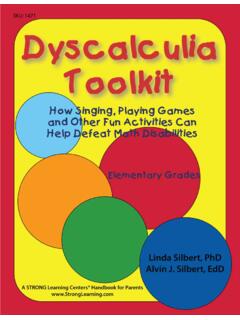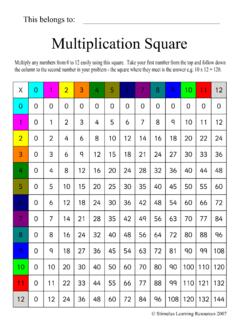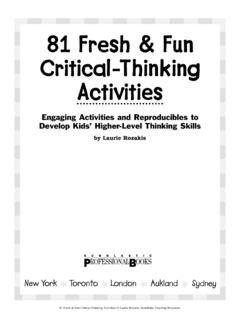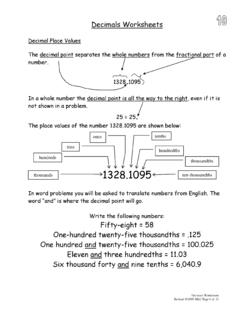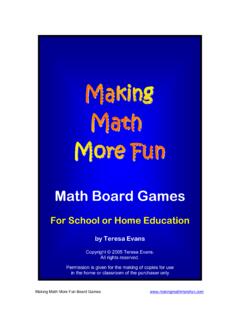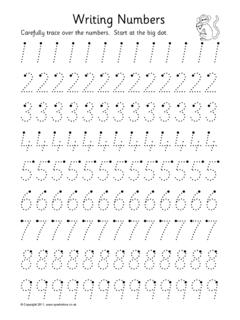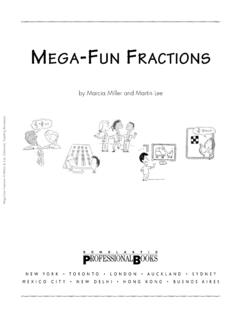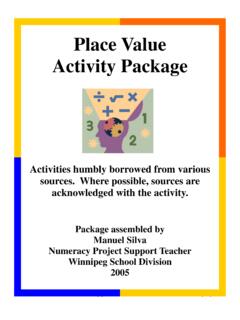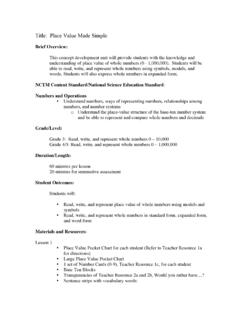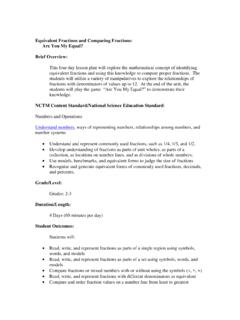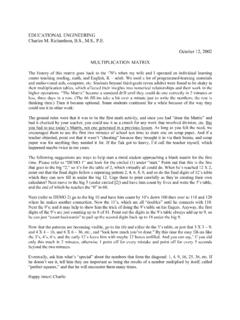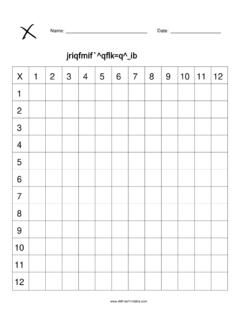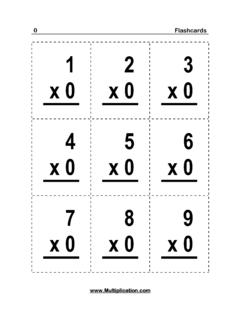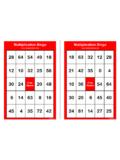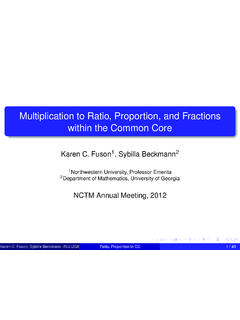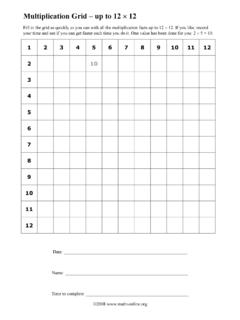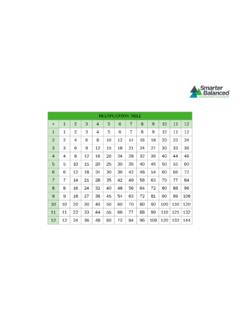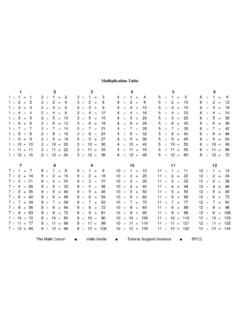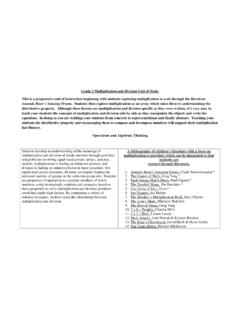Transcription of ideas teaching multiplication tasks - Mathematics Shed
1 MMMuuullltttiiipppllleee DDDooouuubbbllleee GGGrrrooouuupppsss ooofff Some ideas for teaching multiplication tables MMMuuullltttiiipppllliiicccaaatttiiiooon nn PPPrrroooddduuucccttt HHHaaalllvvveee SSSeeetttsss ooofff FFFaaaccctttooorrr MMMuuullltttiiippplllyyy AAArrrrrraaayyy - 2 - The ideas in this booklet have been put together by the Cumbria Numeracy Team to help teachers to widen their bank of ideas for teaching multiplication tables.
2 We have tried to include ideas which link to a range of learning styles. We hope that you and your children find them useful. To contact the numeracy team please contact Sue Atkinson on 01539 773478 or email: - 3 - Use a counting stick as a visual prompt Count in steps of the multiplication table 0, 5, 10 etc Count backwards twice for every once you count forwards Ask questions such as: If 25 is here (pointing to the middle). Where will 35 be? Will it be nearer to 25 or 50? How do you know? Use the stick for reciting multiplication facts. Ask questions such as If you know that 10 x 5 is 50, can you work out what 8 x 5 will be? Move randomly along the stick asking children for the multiplication fact and product. Extend the counting in 5s to counting in 50s, 500s or Can the children see a pattern?
3 Show the pattern on the board and discuss. Extend beyond the counting stick to encourage visualisation. If 10 x 5 = 50 (point to the end of the stick) where will 12 x 5, 15 x 5 be? Point to mark on the counting stick and express it as, for example, 6 x 5 = 30. Ask the children to give an inverse operation. 30 6 = 5 30 5 = 6 - 4 - Use a multiplication table 1 2 3 4 5 6 7 8 9 10 1 1 2 3 4 5 6 7 8 9 10 2 2 4 6 8 10 12 14 16 18 20 3 3 6 9 12 15 18 21 24 27 30 4 4 8 12 16 20 24 28 32 36 40 5 5 10 15 20 25 30 35 40 45 50 6 6 12 18 24 30 36 42 48 54 60 7 7 14 21 28 35 42 49 56 63 70 8 8 16 24 32 40 48 56 64 72 80 9 9 18 27 36 45 54 63 72 81 90 10 10 20 30 40 50 60 70 80 90 100 Use a multiplication table and a piece of L-shaped card to help children find the correct answer.
4 For example 6 x 4 = 24. Encourage children to colour in the facts they already know on a multiplication square. It makes the task of learning the others seem less daunting. - 5 - Limiting the task One of the drawbacks of a traditional multiplication square is the number of facts it contains. Encourage children to concentrate on the facts that they find difficult. There are various ways of doing this: Each child in the class is given (or chooses) a difficult fact. This becomes their fact . The teacher uses this to help the class remember it. For example if the answer to 8x6 is needed the teacher might say Who s fact is that? or, as children start to remember That s Jack s Children who need extra help at a particular multiplication table are given cards with the question on the front and the product on the back.
5 8 x 6 42 An adult goes through the pile with the child. If the child gets the correct answer, the card goes on one pile. If the answer is incorrect it goes onto another pile. The child takes the incorrect pile to learn. Next time go through the correct pile and some of the incorrect. Each time the child gets an incorrect one right put a tick by the product. 42 9 42 999 The ticks moves the card to the correct pile - 6 - Some visual approaches Set the constant function on a calculator and count up and back in steps of 3. Ask questions such as Who can stop at the number nearest to 22? Use dot patterns to show groups being put together: Use arrays. Display posters of key facts. It helps some children to write out the tables facts they are trying to learn. Use a 100 square.
6 Where do the answers to the 4 times table come on a 1 100 square? Is the pattern different on a 0 99 square? What about on a 1 25 square? Use bead strings to illustrate the build up of a multiplication table . - 7 - Some auditory approaches Use times tables tapes or videos. Chanting does help some children, don t discount it. It is useful as one of a range of strategies. Chant as lists of multiples 0, 5, 10, and as whole number sentences 1x5=5, 2x5= Structured chanting using a blank grid can help children to appreciate the links between multiplication tables: 1 2 3 4 5 6 7 8 9 10 X2 X4 X8 Ask the children to chant with you as you point to the blank boxes to build up the 2 times table .
7 Go backwards as well as forwards. Once the pattern starts to be established move down to the 4x row. Do the children start to see links? Talk about doubling. Make up a rap. Say a difficult fact in a funny voice low, high, squeaky, a whisper. Add interest by asking children to shout, whisper, croak answers. - 8 - Make up rhymes for difficult facts. For example Nine fives are forty five snakes alive . Have a fact of the day or week. Point it out to the children at the start of the day and refer to it throughout. Think of rhymes for each multiple of the multiplication table . For example two-shoe, four-door. The teacher then says Two times two is? and the children reply Four-door . - 9 - Some kinaesthetic approaches Put actions to difficult facts.
8 Children can clap, stamp or jump on the difficult fact. Play Knock, Knock . The children work in pairs. Both knock their fists twice on the floor. One child puts out the same number of fingers as the multiplication table being practised. The other child puts out any number of fingers. The winner is the first to say the answer (Make sure the children take it in turns to be the constant number as they have an advantage!) This can be played with both children choosing random numbers. Teach children who need the support to use Cuisenaire rods to build up multiplication tables. Encourage them to move to being able to visualise the rods. Use towers of multi-link and group them to build up the multiplication table . Link multiplication to division through grouping.
9 Give children 24 multi-link cubes. Can they group them into 4s? How many groups are there? Model the vocabulary and the equation if appropriate. Six groups of four is twenty four 6x4=24 . Lay the towers down as a rectangle and show how 4x6 links to what they have found. - 10 - Use finger patterns. Doubles using fingers Counting in fives or twos Nine times- table For three times, fold down the third finger. - 11 - Use fact families Encourage children to learn multiplication and division facts in groups 6x4=24, 4x6=24, 24 6=4, 24 4=6. Tri-corner cards are useful as a visual image. Use a number line to multiply 2 numbers such as 5x3. +5 +5 +5 Then work back from 15 in jumps of 5. How many jumps are there? Encourage children to use known facts I know 5 X 7 = 35, therefore 7 x 7 = 35 + 14 or 35 + 7 + 7 = 49 24 4 x6 Fact families can be recorded in this way.
10 0 5 10 15 0 5 10 15 -5-5-5- 12 - Support for children with specific needs A traditional multiplication square is a useful prompt for some children, but can be confusing for children with specific educational needs such as dyslexia or dyscalculia. Variations which may prove useful are: 4 8 12 16 20 24 28 32 36 Each multiplication table is written on a card as above. The centre box is shaded a different colour. The child is encouraged to build up a visual picture of where each product is shown. For example 3x4 is in the top right hand corner, 8x4 is directly below the central box. When the child comes to learn a different times table the same pattern will apply.
